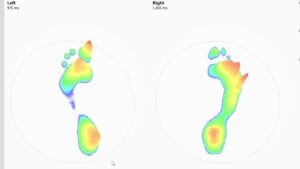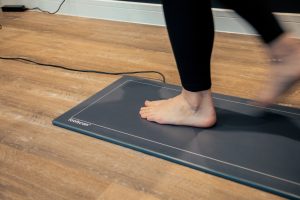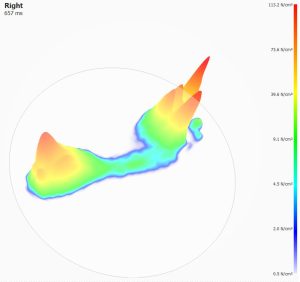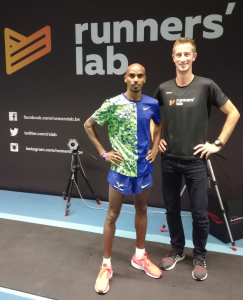6th September 23
How Footscan Can Benefit Runners
What is Gait Analysis/Footscan?
Gait Analysis is an in-depth analysis of how you move, more specifically running and walking. This scientific examination provides comprehensive insights into the way you move.
The ultimate goal of it is to identify any mechanical issues or potential risk factors for injury in a runner’s stride.
By making slight modifications to running form based on these findings, with or without custom made Phits shoe insoles, athletes can enhance their performance, reduce pain and avoid injury, making it an invaluable tool.
Running Gait Analysis Process
Initially, you are asked to stand and then walk or run on the Footscan surface, with or without shoes, while your movement pattern is recorded.
These recordings are then examined by your physiotherapist using cutting-edge software, which helps them evaluate various aspects of the individual’s gait, such as stride length, how the foot lands, pronation type, foot strike pattern, and joint motion.
What Footscan Tells Us
The information gathered from this process aids in identifying any irregularities or concerns in the running or walking pattern that could potentially lead to injuries or hinder performance.
Consequently, personalised recommendations can be made for improving gait mechanics, which may include physical therapy exercises, changes in running technique, or the use of custom Phits shoe insoles.
The Importance of Footscan for Runners
Footscan is of paramount importance for sportspeople for a variety of reasons. Foremost, it uncovers biomechanical abnormalities in a runner’s stride that might otherwise go unnoticed.
Generally, these irregularities can lead to overuse injuries, hinder performance, and may even contribute to pain elsewhere.
Furthermore, Footscan can provide valuable insights into the most suitable type of running shoes for an individual based on their foot strike pattern and stride dynamics. It also plays a crucial role in pain prevention and recovery which can help you achieve your running goals sooner.
Benefits of Custom Phits Insoles for Running Shoes
Custom Phits orthotics are a ground breaking solution for addressing biomechanical irregularities in runners. These tailor-made insoles are designed based on the individual’s unique gait pattern, addressing specific areas of support and cushioning required to enhance running efficiency and comfort.
Custom Phits orthotics can help reduce the risk of overuse injuries by distributing pressure evenly across the foot and correcting foot posture during running.
This way, they can assist in mitigating common running injuries such as plantar fasciitis, runner’s knee, and shin splints. These insoles fit in any footwear ranging from a neutral shoe to running shoe.
Benefits of Phits Orthotics for Posture
Furthermore, by aligning the foot and ankles in the optimal position, these orthotics can contribute to better overall body posture and alignment, helping to alleviate strain on knees, hips, and the lower back.
Lastly, by improving footstrike and running mechanics, custom Phits orthotics can enhance performance, making them an invaluable purchase for athletes aiming for optimal performance and longevity in the sport.
Case Studies Highlighting the Benefits of Gait Analysis
Many professional athletes have reaped the benefits of Footscan. Take Mo Farah, the British long-distance runner and Olympian, for instance. Early in his career, Farah suffered from repeated injuries.
However, detailed gait analysis revealed imbalances in his running style which led to these injuries. Through targeted strength training and adjustments in his running technique based on gait analysis findings, Farah was able to significantly reduce injury risk and went on to secure numerous records and titles in the world of athletics.
Another shining example would be Paula Radcliffe, the women’s world record holder for the marathon. Radcliffe struggled with various injuries at the beginning of her career.
Gait analysis was instrumental in identifying and addressing the biomechanical issues that were at the root of her injury problems. With the insights gained from gait analysis, Radcliffe made modifications to her running form and was able to train more consistently and compete at the highest level for many years, setting a world record that still stands today.
Similarly, Haile Gebrselassie, the Ethiopian long-distance track and road running athlete, benefited enormously from having her gait analysed. Despite his natural talent, Gebrselassie struggled with recurring Achilles problems which threatened his career.
Gait analysis helped identify the underlying cause of these issues. Through corrective exercises, footwear changes, and custom orthotics based on the gait analysis results, Gebrselassie managed to control his Achilles issues and enjoyed a long, successful career.
Common Running Injuries Due to Improper Gait
Previous injuries can make you more susceptible to new injuries, as they may lead to compensatory changes in your gait or running style, potentially placing undue strain on different parts of the body and setting the stage for a new aches and pains.
A large number of running injuries can be traced back to improper gait. One such injury is Runner’s Knee or Patellofemoral Pain Syndrome, which is often caused by an inward movement of the knee during running. This improper gait pattern can lead to pain around the kneecap.
Shin Splints, characterized by pain in the front or inside of the lower leg along the shinbone, is another common injury. It is often linked to excessive pronation (also known as flat feet or low arches) during the gait cycle.
Plantar Fasciitis, a painful condition affecting the bottom of the foot, is often caused by improper foot mechanics during running. A high arch in the foot or a flat foot can change the way weight is distributed during running and put excessive stress on the plantar fascia, leading to inflammation and pain.
Stress Fractures, particularly in the lower leg, ankle and foot, are common among runners and can be a result of improper gait which places undue stress on these areas instead of evenly distributing the force of shock impact to the floor through the entire foot.
IT Band Syndrome, characterised by pain on the outside of the knee, can also be a result of gait abnormalities. The IT band, a ligament that runs along the outside of the thigh, can become tight or inflamed if the foot strikes the ground at an abnormal angle or if the hip drops on the side of the striding leg.
How to prevent these injuries
A comprehensive gait analysis can help identify these improper gait mechanics and provide solutions for correction, highlighting the importance of incorporating this analysis into a runner’s training routine.
Gait analysis stands as a pivotal tool in the realm of running, offering a wealth of benefits that span injury prevention, performance enhancement, and running efficiency improvement.
Gait Analysis Cost
If you were to purchase a Footscan through Carter & George it would cost £90 and the process takes 30 minutes.
Our expert staff will then be able to send you your personal results and treatment plan whether that be exercises, recommended trainers, purchase of running insoles or physiotherapy to help you feel comfortable.
The Carter & George Practice
Carter & George Practice is a renowned physiotherapy clinic that brings elite sports physiotherapy to the general public.
Whether you’re an athlete looking to enhance performance and prevent injury or someone suffering from pain, Carter & George Practice is here to help.





